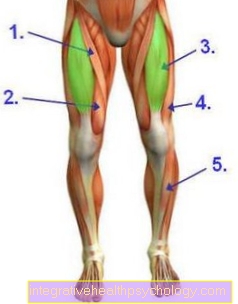Weight training and weight loss
Myth or truth

There are many myths and rumors surrounding the topic of weight loss. One of them, for example, is the idea that you can only lose weight through endurance sports and grow in breadth through strength training. Therefore, many people only do endurance sports and completely forego strength training because they want to lose weight and do not want to gain in breadth again. However, this view is not entirely correct. Due to the high stimuli during strength training, the muscles are stimulated to form new cells in order to form stronger and larger muscles. But this doesn't just happen overnight. Like all organs in our body, muscles need energy to grow. This large amount of energy comes from the food we eat every day. The formation of new muscle cells usually takes place during breaks in training, during which more energy is required due to the formation of new muscle cells than in endurance training. If you now start strength training and do not change your diet, the increased energy requirement in the training breaks will lead to the lack of energy from the fat reserves being drawn on so that the muscles can still form new cells with higher energy requirements and the same amount of food.
Here it becomes clear that the myth "strength training only makes you wide and does not help you lose weight" is not true.
Positive effects
For a healthy weight loss you should definitely not do without strength training. For men and women alike, a combination of strength training and endurance training is the healthiest and best way to lose weight.
Strength training creates several beneficial effects that help you lose weight. On the one hand, through strength training, the energy requirement will still have a higher value after the training, so that a slightly higher calorie consumption can still be determined in the recovery phase. Furthermore, strength training has the advantage in the long term that more muscle mass also consumes more energy and thus the body's basal metabolic rate increases at rest. This phenomenon of increased energy requirements after strength training is called the afterburn effect. The afterburn effect describes an increased metabolic activity after training. The metabolism works at full speed during the training and of course the metabolism does not shut down completely after the training is finished. Oxygen uptake is also increased after strength training and does not drop directly to the resting value.
Other influencing factors such as core body temperature and stress level also play a role. The stress hormones adrenaline and noradrenaline control metabolism, breathing and heart activity. The higher the training intensity, the higher the level of stress hormones. Hard training thus produces a higher afterburn effect than moderate training. The increased energy requirement for the afterburn effect can be explained by the regeneration mechanisms of the body and the replenishment of the energy stores. The breakdown and removal of metabolic products also costs the body energy. With the afterburning effect, this alone can account for up to 15%. In addition, the body needs energy to convert proteins into amino acids. Another influencing factor is the muscle tension, which can be increased up to two days after a workout, and which also increases the calorie requirement, even if only minimally.
What might also interest you: Lose weight on the stomach, lose weight on the thigh - how fast does it really work?
Negative energy balance

If you have trained an additional kilogram of muscle mass after a certain period of time, these extra muscles consume 20 kilocalories every day in complete rest (kCal) extra. This means that the body uses more energy because more muscle mass needs to be supplied. This increased energy requirement then also has a direct effect on body fat. If you stick to your eating plan, but now have to supply more muscle mass, then an energetic imbalance arises. Because of the additional muscles, the body needs more energy than is made available to it through food. The energy balance slips into negative territory.
An example can illustrate this. A man consumes 3000 kCal per day and hardly moves, so that his energy requirement is 2800 kCal. The body ingests more calories than it can use, the person gains weight. On the one hand, strength training increases the basal metabolic rate, and the increased muscle mass also consumes calories. The person's energy requirement has risen from 2800 kCal to 3200 kCal. However, 3000 kCal of energy are still absorbed through food. So the body uses 200 kcal more every day than it has available through food. In order to compensate for this missing 200 kCal, the body gets the missing energy from the fat stores created for "bad times". The person is slowly but steadily losing weight.
Furthermore, strength training ensures better well-being and can also be helpful in reducing stress. In order to lose weight effectively through strength training, there are a few hints and tips that you should follow.
Read more about this under Lose weight with protein powder
Entry into strength training
If you start with strength training you shouldn't take over yourself directly, but rather start with small weights and get to know his strength development. Only when you have determined your level of training should you deal with the Establishing a training plan deal. In the Training frequency one should also approach slowly. Sufficient at the beginning two to three units per weekso that the body can get used to the stress. You can then integrate a fourth training session. The Training length should between 30 and 60 minutes because strength training requires maximum performance and the body is stressed. An important point here is that recreation. There should be one between each training session full day break for regeneration lie. Recovery is important so that the body can prepare for the following stresses and replenish its energy stores. The recovery break is essential for the formation of new muscle cells.
Training plan and exercises

When creating a training plan, you should make sure that your own needs and training goals are reflected. Beginners should first consult an expert when creating theGym or personal trainer) turn. With a little experience and practice, however, you can easily set up a training plan yourself. The choice of exercises also plays an important role in the training result. If possible, all major muscle groups should be used in one training session. The following standard strength exercises are recommended: bench presses, squats, deadlifts, pull-ups, dips, shoulder presses, and barbell rows.
Another variant is split training. The exercises are split up over two days so that on the first day e.g. the lower extremities and core are trained. On the second day of training, the upper body, shoulders and arms follow. Before you use or split your training plan, you should be sure to master the exercises. Again, it is recommended to ask an expert, as some exercises are not that easy to perform. Correct execution and technique prevents injuries and ensures effective training. In order to learn the technique, it is advisable to always try the exercises with light weights first.
Number of sets and repetitions
When training itself, you should make sure that you have free weights and as much as possible Dumbbells prefers machines. This has several advantages. You get one with free weights better feeling of movement and simultaneously stabilizes the muscles involved. Most of all coordination and balance will benefit from it.
In the Number of repetitions it depends on the training goal. If you want to lose weight, you should first build up muscles. We recommend a form of training in which one about five sets of five to twelve repetitions performs. More muscle mass again means one higher basal metabolic rate, which then has a positive effect on weight loss. Assuming five sentences, the following exercise sequence results. To prepare for the exercise, one begins first set with very low weights. Sets two and three are then performed with increasingly higher weightsto slowly approach the maximum. The The last two sets are then carried out in a controlled manner at the limitto set an effective training stimulus. Only an appropriate training stimulus ensures a high level of stress on the muscles, and thus also for muscle growth.
So that the training does not get boring in the long run, you should make sure that the Training plan enough variety contains. Exercises can be replaced or varied for this purpose. When replacing, for example, exercises such as squats and pull-ups can be replaced by more isolated exercises. This creates a new stimulus and makes the training more varied. What every athlete or athlete should keep in mind is that the sport should be fun. There are many different sports, and only one sport that is fun will be continued consistently. So you should think carefully about whether you want to do strength training to lose weight or whether another sport might better suit your personal interests and preferences.
Summary
If you compare endurance sports with strength training in terms of weight loss, the following conclusions can be drawn. Strength training tends to build muscle, whereas endurance training can lead to muscle loss, because some muscles are not or hardly used. The movement patterns in endurance sports are too one-sided to always use all muscles effectively. In strength training, the Muscle building of 2.5 kilograms of muscle mass burn an additional 1500 kCal every month. It becomes clear that strength training is a very effective method for weight loss, because the basal metabolic rate can be increased for up to two days even after a workout thanks to the afterburn effect, and because the increase in muscle mass also leads to an increase in the basal metabolic rate. Of course you should keep your diet or change it so that it is a balanced, healthy diet. It is particularly important that the calories consumed per day are higher than the calories ingested through food.
Anyone who is overweight and has just started strength training is allowed to not surprised, if after a few weeks there hasn't been too much on the scales. Since strength training builds muscle mass, you may at first hardly loses any weight as muscles are built and fat is broken down. The reduction is initially limited. The effectiveness of strength training only becomes apparent from a certain point and you lose weight steadily and healthily, and you can reduce your fat percentage in your body composition.

















-mit-skoliose.jpg)











